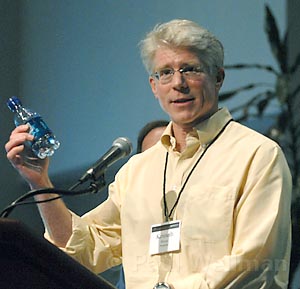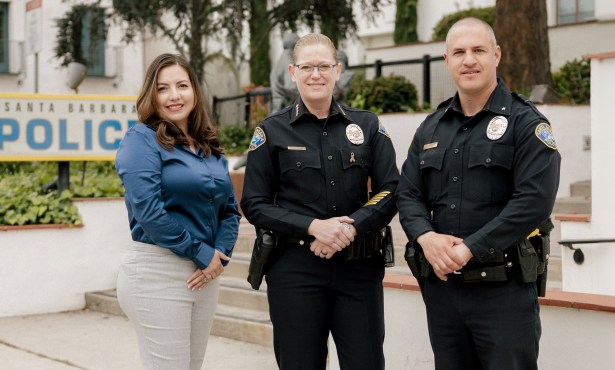Pulitzer Winner Ken Weiss at UCSB
Reporter Talks About His "Altered Oceans" Series

Carpinteria resident Ken Weiss, winner of the 2007 Pulitzer Prize, was a brilliant fisherman as child, or so he told an audience at UCSB’s Corwin Pavilion on Saturday, April 29. His luck diminished as he grew older, but the reason for this reversal of fortune didn’t fully dawn on him until he started covering the coast and oceans as a reporter for the Los Angeles Times.
Just as he had wondered where all the bonita and barracudas had gone that he used to catch so easily, Weiss listened to frustrated marine biologists give report after report on the increasing scarcity of organisms and ecosystems they were trying to study. Scientists were putting their jigsaw puzzle pieces of the ocean together and coming to chilling conclusions about the reverse evolution of the oceans away from larger organisms, toward a more primitive soup dominated by algae and bacteria.
In a five-part series of front page articles for the Los Angeles Times, published last summer, Weiss conveyed this change in vivid terms – not incidentally popularizing the phrase “the rise of slime.” When the Pulitzer Prize winners were announced on April 16, Weiss learned that he had won in the category of Explanatory Journalism. On stage at UCSB’s conference on Media and the Environment, Weiss was accompanied by John Vande Wege, who wrote the scripts, adapted from Weiss’s stories, for the Timess multimedia website presentation of “Altered Oceans”
Weiss’s talk focused not so much on how he got the story as how he managed to sell it to his editor and the public. Too many environmental stories are based on “future or conditional threats,” he said, so they take a back page to events happening at the moment – from Middle East explosions to celebrity weddings. “So I’m waving a new inch-thick report on the infighting over setting limits on bacteria in coastal waters – with the awful name, Total Maximum Daily Load, and worse acronym, TMDLs – and this is what I’m up against,” Weiss told the audience. Making matters worse, there is not even a convenient villain to blame, he said: no corrupt official, no chemical company illegally dumping waste, not even a balky government agency.
Weiss credited editor Dean Baquet (who was “dismissed along with our publisher last year for standing up to our corporate bosses pressing for more layoffs”) for letting him pursue the story, which he worked on for the better part of 18 months. The way he made it interesting was to document – with photographer Rick Loomis, who carried both a still and a video camera – the effects already being wreaked by the change in the sea.
Weiss and his team documented streams of plastic flowing down the Los Angeles River channel to the sea, and then they visited the Pacific atolls where, in a nightmarish variation on The March of the Penguins, albatross chicks are dying by the thousands of dehydration and starvation because their stomachs are stuffed full of the plastic being fed to them by their mothers. “The idea here was to show the public that things aren’t going, perhaps, the way nature intended,” said Weiss. “We used every narrative trick we could to make it accessible and slip in the science.”
Closer to home, they visited marine mammal rehabilitation centers populated by brain-damaged sea lions, a pathetic scene. The animals’ hippocampuses were shriveled by domoic acid, a neurotoxin produced by an algae now blooming in unnatural quantities off the California coast. This week, California Fish and Game officials warned people not to eat shellfish, sardines, or the internal organs of crustaceans because of the risk of domoic acid poisoning. Dozens of other toxin-producing algae species are burgeoning in coastal waters all over the world. The cause, according to Weiss, is the plant nutrients washing into the seas from agricultural fields, gardens, and sewage treatment plants. This is exacerbated by the removal of fish and wetlands that function as natural filters.
And then there is the acidification of the seas, which threatens shell-formation, which relies on the seas’ alkalinity. Horror stories, to be sure, but these are meant to be inspiring rather than depressing, said the conference’s emcee. And they succeeded thanks largely to the dedication of the scientists who are grappling with the situation, which has a certain heroic charm that the series also demonstrated. Weiss has reason to be familiar with that quality: He is the brother of Nancy Weiss, the distinguished Santa Barbara environmental and social justice activist.
Weiss has done follow-up stories since the series, including at least one examining market-based solutions to the problem. He said it’s easier to write compellingly about problems than about solutions.
Weiss’s colleague Vande Wege wrapped up the presentation on a hopeful note for quality journalism. Newspapers, he said, “are well positioned to compete in the new media world. We’ve got the content, the in-depth reporting, and analysis that can go beyond the eyeball-grabbing video clip by also telling us what it means.”



